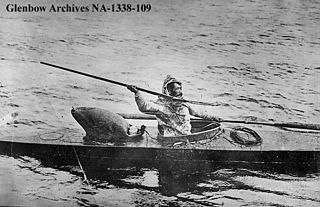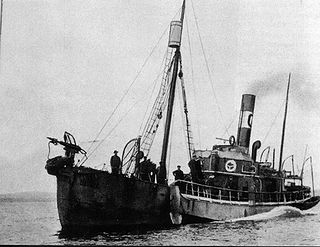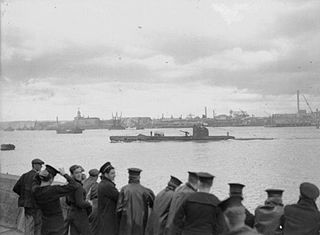
A harpoon is a long spear-like instrument used in fishing, whaling, sealing, and other marine hunting to catch large fish or marine mammals such as whales. It accomplishes this task by impaling the target animal and securing it with barb or toggling claws, allowing the fishermen to use a rope or chain attached to the butt of the projectile to catch the animal. A harpoon can also be used as a weapon.

Operation Arctic Fox was the codename given to a World War II campaign by German and Finnish forces against Soviet Northern Front defenses at Salla, Finland in July 1941. The operation was part of the larger Operation Silver Fox which aimed to capture the vital port of Murmansk. Arctic Fox was conducted in parallel to Operation Platinum Fox in the far north of Lappland. The principal goal of Operation Arctic Fox was to capture the town of Salla and then to advance in the direction of Kandalaksha to block the railway route to Murmansk.
The XXXVI Corps was a German military formation in World War II.
Mountain Corps Norway was a German army unit during World War II. It saw action in Norway and Finland.

The 169th Infantry Division was a German military unit during World War II.

The Jarmann M1884 is a Norwegian bolt-action repeating rifle designed in 1878 adopted in 1884. The Jarmann is the first centerfire, repeating bolt-action rifle, adopted as standard issue based on an entirely new design. Earlier rifles like the Swiss Vetterli used rimfire cartridges, the Winchester Hotchkiss and early models of the Remington Lee saw only limited military use, the German Mauser Model 71/84 and early Kropatschek rifles were based on earlier designs. The Jarmann's adoption, and subsequent modifications, turned the Norwegian Army from a fighting force armed with single-shot black-powder weapons into a force armed with modern repeating weapons firing smokeless ammunition. Several thousand were manufactured to equip the Norwegian Armed Forces in the 1880s, and it also saw some, though very limited, use in Sweden. The design is unique, and was the brainchild of Norwegian engineer Jacob Smith Jarmann. After the design had been phased out of the Norwegian Army, a number of the weapons were rebuilt as harpoon guns.

The 2nd Army was a World War II field army.
The German Lapland Army was one of the two army echelon headquarters controlling German troops in the far north of Norway and Finland during World War II. It was established in January 1942, and renamed the 20th Mountain Army in June 1942. On 18 December 1944, the 20th Mountain Army absorbed the German 21st Army.
Operation Harpoon may refer to:

A whaler or whaling ship is a specialized ship, designed, or adapted, for whaling: the catching or processing of whales. The former includes the whale catcher – a steam or diesel-driven vessel with a harpoon gun mounted at its bow. The latter includes such vessels as the sail or steam-driven whaleship of the 16th to early 20th centuries and the floating factory or factory ship of the modern era. There have also been vessels which combined the two activities, such as the bottlenose whalers of the late 19th and early 20th century, and catcher/factory ships of the modern era.
The explosive harpoon is a type of harpoon which uses an explosive discharge to assist in whaling. In Norway, Japan, and Iceland, penta-erythritol tetra-nitrate is used in harpoon grenades. These are steel canisters that thread onto the tip of a reusable harpoon and explode by means of a hook and trigger line when they have penetrated approximately half a meter into the whale. Shrapnel and hooks that are attached to the harpoon cable are lodged into the whale's body, inhibiting the whale's ability to escape. A cable then reels the whale in as it draw its last breath. Norway uses more advanced and more expensive grenades. They claim that 80% of whales are killed instantly. Iceland uses the Norwegian grenades, which can kill even large fin whales instantaneously 84% of the time. In Japan, the use of harpoons has been shown to yield a poor rate of instantaneous fatalities.
Whaling in Norway involves subsidized hunting of minke whales for use as animal and human food in Norway and for export to Japan. Whale hunting has been a part of Norwegian coastal culture for centuries, and commercial operations targeting the minke whale have occurred since the early 20th century. Some still continue the practice in the modern day.

HMS Unbroken (P42) was a Royal Navy U-class submarine built by Vickers-Armstrong at Barrow-in-Furness, and it was part of the third group of that class and has been the only vessel of the Royal Navy to bear the name.

The M28 Jarmann harpoon rifle was a modification of the Jarmann M1884 Norwegian service rifle.

The Harpoon is an all-weather, over-the-horizon, anti-ship missile system, developed and manufactured by McDonnell Douglas. In 2004, Boeing delivered the 7,000th Harpoon unit since the weapon's introduction in 1977. The missile system has also been further developed into a land-strike weapon, the Standoff Land Attack Missile (SLAM).
The Army of Norway, also simply Army Norway, was a German army operating in the far north of Norway and Finland during World War II. The Army of Norway was under Armeeoberkommando Norwegen, abbreviated AOK Norwegen, which was one of the two army echelon headquarters controlling German troops in the far north.

Armeeoberkommando was a command level in the German and Austro-Hungarian armies, especially during the World War I and World War II. It was equivalent to a British, French, American, Italian, Japanese, or Imperial Russian "Army".

The Imperial and Royal General Staff of Austria-Hungary was part of the Ministry of War. It was headed by the Chief of the General Staff for the Whole Armed Forces, who had direct access to the Emperor.
Katharine "Ketty" Guttmann was a German Communist politician and campaigner for prostitutes' rights.












